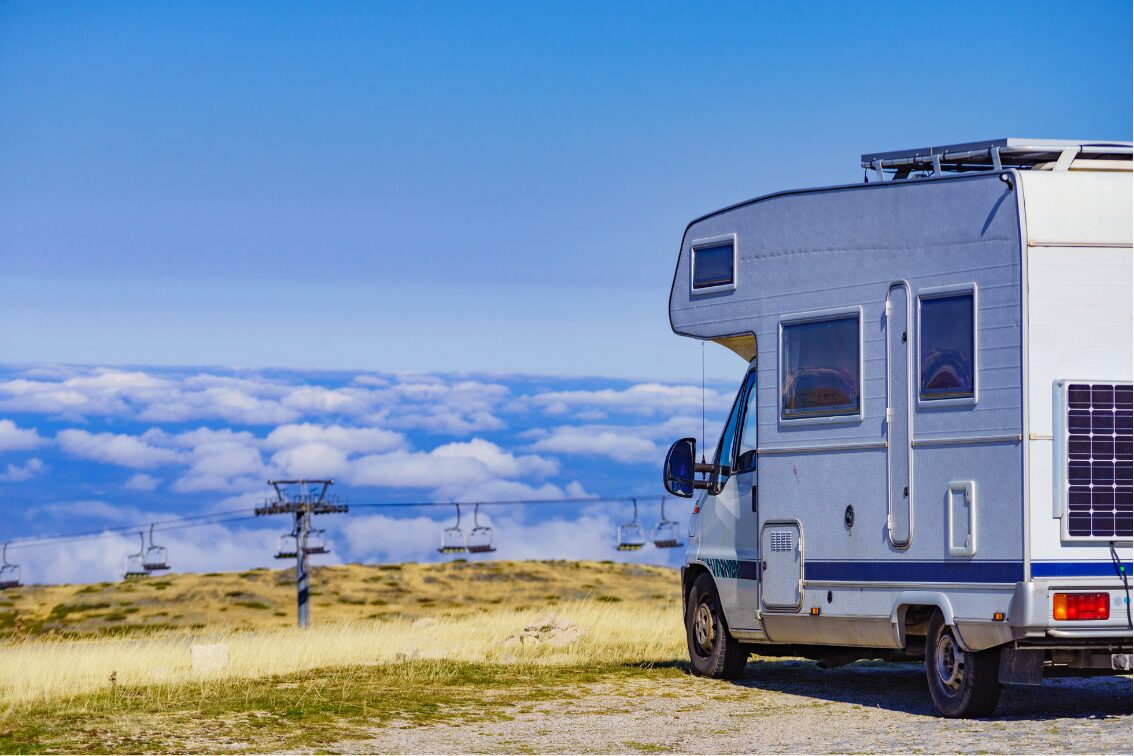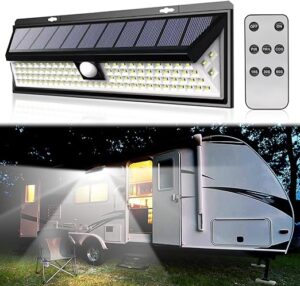*This post may contain affiliate links for which I earn commissions.*
Hitting the open road in your RV during summer can be the epitome of adventure and freedom. The thrill of discovering new places, the joy of setting up camp in a serene spot, and the endless possibilities for outdoor fun are all part of the charm. But as any seasoned RVer will tell you, the summer sun can turn your cozy home on wheels into a sweltering sauna if you’re not prepared.
Keeping your RV cool in the heat of summer is more than just a comfort issue—it’s essential for your health and well-being. Overheating can sap your energy, ruin your mood, and even pose serious health risks. Luckily, with a few smart strategies and a bit of planning, you can beat the heat and make sure your summer travels are as cool and enjoyable as you envisioned.
Whether you’re a full-time RVer or a weekend warrior, this guide is packed with practical tips and tricks to help you stay cool and comfortable on the road. From prepping your RV with the right gear to simple DIY hacks and smart travel tips, we’ve got you covered. So, let’s dive in and discover how to turn your RV into a cool oasis, no matter how high the mercury climbs!
Preparing Your RV for the Heat
Before you hit the road, it’s crucial to prepare your RV to handle the summer heat. A few upgrades and tweaks can make a significant difference in keeping your living space cool and comfortable.
Insulation Upgrades
One of the most effective ways to combat the heat is by enhancing your RV’s insulation. Start with adding thermal curtains and shades to your windows. These can block out a significant amount of heat and help maintain a cooler interior. Reflective window covers, often made of materials like Reflectix, can also be a game-changer. These covers reflect sunlight away from your RV, reducing the amount of heat that enters.
Ventilation Improvements
Proper ventilation is key to keeping your RV cool. Installing roof vents and fans can help expel hot air and draw in cooler air. Consider adding a vent cover that allows you to keep the vent open even during rain. Window and door screens are also essential; they let you keep windows and doors open for airflow without letting in bugs.
Sealing and Weatherproofing
Heat can easily seep in through gaps and leaks in your RV. Take the time to inspect your RV for any areas where air might be escaping. Use weather stripping on doors and windows to create a tight seal. Caulking around seams and joints can also prevent unwanted heat from creeping in. A well-sealed RV not only stays cooler but also becomes more energy-efficient.
By taking these steps to prepare your RV, you’ll create a more comfortable environment for your summer travels. These upgrades might require a bit of effort upfront, but they pay off by making your RV a cooler and more enjoyable place to be during those hot summer days.
Cooling Systems and Devices
Once your RV is prepped and ready, it’s time to think about the cooling systems and devices that can help you maintain a comfortable temperature. There are various options to consider, each with its own set of benefits.
Air Conditioning Units
An air conditioning unit is often the most effective way to cool your RV. There are several types of RV air conditioners to choose from, including roof-mounted, portable, and window-mounted units. Roof-mounted units are popular for their space-saving design, while portable and window-mounted options offer flexibility.
To maximize the efficiency of your AC unit, be sure to:
- Keep filters clean to ensure optimal airflow.
- Close windows and doors when the AC is running to prevent cool air from escaping.
- Use a programmable thermostat to maintain a consistent temperature without wasting energy.
Portable Fans and Evaporative Coolers
If you’re looking for a more energy-efficient option, portable fans and evaporative coolers can be excellent choices. Portable fans, especially those powered by batteries or USB, are great for targeting specific areas and providing immediate relief. For a more widespread cooling effect, consider using multiple fans throughout your RV.
Evaporative coolers, also known as swamp coolers, use water to cool the air and can be very effective in dry climates. They consume less power than traditional air conditioners and can be a good alternative if you’re looking to conserve energy.
Dehumidifiers
Humidity can make high temperatures feel even more unbearable. A dehumidifier helps by reducing the moisture in the air, which can significantly enhance your comfort. Choose a dehumidifier that suits the size of your RV to ensure it effectively manages the humidity levels.
By equipping your RV with the right cooling systems and devices, you can create a comfortable environment that makes your summer travels enjoyable. Remember, the goal is to find a balance between staying cool and using energy efficiently, so choose the options that best fit your travel style and needs.
Power Management
Managing your power usage effectively is crucial for keeping your RV cool, especially if you rely on energy-intensive devices like air conditioners. Here are some strategies to help you balance your power needs with available resources.
Using Generators and Solar Panels
Generators are a common power source for RVers, providing a reliable way to run your air conditioner and other cooling devices. However, they can be noisy and require fuel. To make the most of your generator:
- Use it during peak heat hours when cooling is most needed.
- Combine generator use with other power-saving strategies to minimize fuel consumption.
Solar panels offer a quieter and more sustainable power option. While they might not be able to run an air conditioner on their own, they can power fans, lights, and other small devices, reducing the overall load on your generator or RV batteries. To maximize efficiency:
- Install a sufficient number of panels to meet your energy needs.
- Use a solar power inverter to convert solar energy into usable electricity for your devices.
Battery Maintenance
Keeping your RV batteries in good condition is essential for reliable power. Regular maintenance can help extend their lifespan and ensure they’re ready when you need them most. Tips for maintaining your batteries include:
- Checking electrolyte levels and topping them off with distilled water if needed.
- Cleaning battery terminals to prevent corrosion.
- Ensuring batteries are fully charged before embarking on your trip.
Using power-saving modes on your devices and appliances can also help conserve battery life. Many modern RVs come equipped with energy-efficient features, but you can further optimize by:
- Turning off devices when not in use.
- Using energy-efficient LED lights.
- Charging devices during the day when solar power is available.
By effectively managing your power sources and maintaining your batteries, you can ensure a steady supply of energy to keep your RV cool and comfortable during your summer travels.
Smart Travel Tips
In addition to preparing your RV and managing your power effectively, planning your travels with heat in mind can make a big difference. Here are some smart travel tips to help you stay cool on the road.
Travel During Cooler Times
One of the simplest ways to avoid the worst of the heat is to plan your travel during cooler parts of the day. Early mornings and late evenings are generally cooler, making them ideal for driving and setting up camp. Here’s how to make the most of your travel times:
- Early Departures: Hit the road early to avoid midday heat. You’ll also enjoy quieter roads and beautiful sunrises.
- Late Arrivals: Arriving at your destination in the evening allows you to set up camp in cooler conditions.
Optimal Parking Strategies
Where you park your RV can significantly affect how hot it gets inside. Here are some parking strategies to keep your RV cool:
- Seek Shade: Park under trees or other shaded areas whenever possible. If natural shade isn’t available, use your RV’s awning or set up a tarp to create artificial shade.
- Consider the Sun’s Path: Position your RV so that the side with the most windows faces away from the sun. This reduces the amount of direct sunlight entering your RV.
- Use Reflective Covers: Place reflective covers on your RV’s roof and windows to bounce the sun’s rays away and keep the interior cooler.
Choose Cooler Destinations and Elevations
When planning your route, consider destinations that offer natural cooling benefits. Higher elevations, for example, tend to have cooler temperatures. Coastal areas often have breezes that can help keep things cool. National parks and forested areas can also provide natural shade and cooler environments.
By being strategic about your travel times and destinations, you can minimize your exposure to extreme heat and enjoy a more comfortable RV experience.
DIY Cooling Hacks
Sometimes, simple DIY solutions can make a big difference in keeping your RV cool. Here are some handy hacks to try:
Homemade Air Conditioners
Creating a homemade air conditioner can be a fun and effective way to cool down your RV. One popular method involves using a portable cooler filled with ice and a small fan. Here’s how to make one:
- Materials Needed: A portable cooler, a small battery-powered or USB fan, ice, and a PVC elbow pipe.
- Assembly: Cut a hole in the lid of the cooler for the fan and another hole for the PVC pipe. Place the fan in one hole, blowing into the cooler, and the PVC pipe in the other hole, acting as the cool air outlet.
- Usage: Fill the cooler with ice and turn on the fan. The fan blows air over the ice, creating cool air that exits through the PVC pipe.
Reflective Sunshades and Covers
Using reflective materials can significantly reduce heat gain. You can make your own reflective covers for windows and the roof of your RV:
- Materials Needed: Reflective insulation material (like Reflectix), scissors, and Velcro strips.
- Assembly: Cut the insulation material to fit your windows and roof. Attach Velcro strips to secure them in place.
- Usage: Install these covers during the hottest parts of the day to reflect sunlight away from your RV.
Cool Water Bottles and Towels

Simple items like ice packs, frozen water bottles, and cooling towels can provide instant relief from the heat:
- Ice Packs and Frozen Water Bottles: Place them in front of fans to blow cool air around your RV.
- Cooling Towels: Soak towels in cold water, wring them out, and drape them over your neck or shoulders for a refreshing cool-down. You can also store them in the fridge or freezer for an extra chill.
By incorporating these DIY cooling hacks, you can enhance your comfort and enjoy your summer RV travels even in the hottest conditions.
Lifestyle Adjustments
Beyond physical preparations and devices, adjusting your daily habits and routines can significantly enhance your comfort during hot summer travels. Here are some practical lifestyle adjustments to help you stay cool in your RV.
Staying Hydrated

Staying hydrated is crucial for maintaining your body’s ability to regulate temperature. Here are some tips to ensure you’re drinking enough water:
- Drink Regularly: Sip water throughout the day, even if you don’t feel thirsty. Set reminders if needed.
- Keep Water Accessible: Have a water bottle within easy reach at all times. Insulated bottles can keep water cool for longer.
- Infuse with Flavor: Add slices of fruit or herbs like mint to your water to make it more appealing and refreshing.
- Monitor Intake: Aim for at least eight glasses of water a day, more if you’re very active or sweating heavily.
Wearing Light and Breathable Clothing
Choosing the right clothing can make a significant difference in how you feel in the heat. Opt for light, breathable fabrics that allow air to circulate and help wick away sweat:
- Light Colors: Wear light-colored clothing to reflect sunlight rather than absorb it.
- Breathable Fabrics: Choose fabrics like cotton, linen, and moisture-wicking synthetics. Avoid heavy, dark, or tight-fitting clothes.
- Loose Fit: Loose-fitting clothes allow better airflow and help keep you cool.
Cooling Activities

Incorporate activities into your day that help you cool down and stay refreshed:
- Swimming and Water Activities: Take advantage of lakes, rivers, or pools at your campsite. Even a quick dip can lower your body temperature.
- Evening Walks: Schedule outdoor activities like hiking or sightseeing for early morning or late evening when temperatures are lower.
- Cool Showers and Baths: Take cool showers or baths to quickly lower your body temperature. You can also soak your feet in a basin of cold water for a quick refresh.
By making these lifestyle adjustments, you can enhance your overall comfort and enjoy your summer travels more, even when the temperatures soar.
Emergency Cooling Measures
Despite your best efforts to stay cool, there may be times when the heat becomes overwhelming. It’s important to recognize the signs of heat-related illnesses and know how to respond effectively.
Recognizing Signs of Heat-Related Illness
Understanding the symptoms of heat-related illnesses can help you take quick action to prevent serious health issues:
- Heat Exhaustion: Symptoms include heavy sweating, weakness, cold, pale, and clammy skin, a fast, weak pulse, nausea or vomiting, and fainting.
- Heat Stroke: Symptoms include high body temperature (above 103°F), hot, red, dry, or damp skin, rapid and strong pulse, and possible unconsciousness. Heat stroke is a medical emergency and requires immediate attention.
Immediate Cooling Actions
If you or someone in your RV starts showing signs of heat exhaustion or heat stroke, take the following steps:
- Move to a Cooler Area: Get out of the heat and into a shaded or air-conditioned space.
- Hydrate: Drink cool water or an electrolyte beverage. Avoid caffeine and alcohol.
- Cool the Body: Use cold compresses, ice packs, or a cool bath to lower body temperature. Place cold, wet cloths on the neck, wrists, armpits, and groin.
- Loosen Clothing: Remove any tight or unnecessary clothing to help the body cool down.
By being prepared to recognize and respond to heat-related emergencies, you can protect yourself and your travel companions from serious health risks during your summer RV adventures.
Conclusion
With the right preparation, cooling systems, smart travel strategies, and lifestyle adjustments, you can beat the heat and enjoy your summer RV travels to the fullest. Remember, staying cool is not just about comfort—it’s about staying safe and healthy. By following these tips and being mindful of your environment, you can turn your RV into a cool oasis and make the most of your summer adventures on the open road. Happy travels!
Related articles:
How to Stay Cool at Summer Festivals and Outdoor Events | Heat Wave Hacks
Ultimate Guide to Choosing the Best Beach Tent or Sunshade | Heat Wave Hacks
Effective Ways to Stay Cool During a Heatwave | Heat Wave Hacks
🙋♀️ For more detailed reviews and tips on staying cool, be sure to explore other posts on our website. Check out our in-depth product reviews to find the best cooling solutions for your needs. Don’t forget to share your own experiences and tips in the comments below. Stay cool and beat the heat with Heatwave Hacks!



